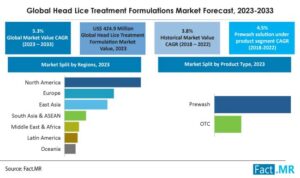Head lice infestations are a common and persistent concern, especially among school-aged children. Over the years, the battle against these tiny pests has led to remarkable advancements in the field of head lice treatment formulations. In this blog, we delve into the dynamic landscape of the Head Lice Treatment Formulations Market, exploring the latest innovations, challenges, and solutions that are transforming the way we address this age-old problem.
For More insights into the, Request a Sample of this Report:
The Need for Effective Solutions:
Head lice, tiny insects that thrive on the scalp and feed on human blood, can cause discomfort, itchiness, and embarrassment. These infestations are often characterized by their resilience, as lice can develop resistance to conventional treatments. As a result, there has been a growing demand for innovative and effective head lice treatment formulations that can tackle infestations while minimizing side effects and inconveniences.
Innovative Treatment Approaches:
The Head Lice Treatment Formulations Market has witnessed a surge in innovation, with researchers and companies working tirelessly to develop new and improved solutions. One notable development is the emergence of pesticide-free and non-toxic treatments, catering to the increasing demand for safer alternatives. Natural ingredients such as essential oils, enzymes, and plant extracts are being harnessed for their potential in eradicating lice without the drawbacks of traditional chemical treatments.
Market Trends:
- Rise of Natural and Non-Toxic Formulations:
Consumers have been increasingly seeking safer and non-toxic alternatives for head lice treatments. This has led to a growing demand for natural and organic formulations that utilize ingredients such as essential oils (e.g., tea tree oil, neem oil), enzymes, and plant extracts to effectively combat head lice without the potential side effects associated with traditional chemical treatments.
- Combination Therapies:
To counter the issue of resistance that head lice can develop to single active ingredients, there has been a trend toward developing combination therapies. These formulations incorporate multiple active ingredients that target different stages of the lice life cycle, making it more difficult for lice to develop resistance and increasing the overall effectiveness of the treatment.
- Innovative Delivery Systems:
New delivery methods and devices have emerged to improve the efficacy and convenience of head lice treatments. Foams, gels, and electronic devices that use controlled heat to eliminate lice have gained attention for their potential to enhance treatment outcomes and user experience.
- Increasing Awareness and Education:
Efforts to raise awareness about head lice prevention, identification, and treatment have been on the rise. Schools, healthcare professionals, and organizations have been working to educate parents, caregivers, and children about effective ways to prevent and manage head lice infestations.
- Telemedicine and Digital Solutions:
The advancement of telemedicine and digital health platforms has enabled remote consultations and guidance for head lice treatment. Healthcare providers and experts can offer advice and recommendations virtually, making it more convenient for individuals seeking assistance with head lice infestations.
- Product Accessibility and Availability:
There has been a focus on ensuring that effective head lice treatment formulations are accessible and available to a wide range of demographics. Efforts have been made to provide affordable options that cater to different socioeconomic groups.
Advanced Delivery Systems:
Advancements in delivery systems have also played a pivotal role in shaping the market. Traditional shampoos and lotions are now being complemented by novel formulations such as foams, gels, and even electronic devices designed to kill lice through controlled heat application. These innovative delivery methods not only enhance the efficacy of treatments but also improve user experience, making the process more convenient and user-friendly.
Combating Resistance:
As lice develop resistance to certain chemical ingredients, the market has responded by exploring novel approaches to combat this challenge. Some formulations incorporate multiple active ingredients to target different stages of the lice life cycle, reducing the likelihood of resistance. Additionally, combination therapies that combine different treatment methods are being studied to provide a comprehensive and effective approach to head lice eradication.
Challenges and Future Outlook:
While the Head Lice Treatment Formulations Market continues to innovate, it also faces its share of challenges. Regulatory approvals, public perception of natural remedies, and ensuring the accessibility of these treatments to different demographics are factors that require careful consideration. However, the market is poised for growth as consumers increasingly seek safer, more efficient, and user-friendly options to address head lice infestations.
Conclusion:
The Head Lice Treatment Formulations Market stands at the forefront of innovation, bringing forth a range of effective and advanced solutions to combat head lice infestations. From pesticide-free formulations to innovative delivery systems, the market’s evolution reflects a commitment to addressing a common problem with modern ingenuity. As research and development continue to pave the way for safer, more efficient treatments, individuals and families can find solace in the fact that head lice infestations are no longer an insurmountable challenge, but rather a hurdle that can be overcome with the aid of innovative formulations.
